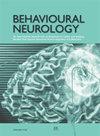Amyotrophic Lateral Sclerosis and Pain: A Narrative Review from Pain Assessment to Therapy
IF 2.7
4区 医学
Q2 CLINICAL NEUROLOGY
引用次数: 0
Abstract
Amyotrophic lateral sclerosis (ALS) is the most frequent neurodegenerative disease of the motor system that affects upper and lower motor neurons, leading to progressive muscle weakness, spasticity, atrophy, and respiratory failure, with a life expectancy of 2–5 years after symptom onset. In addition to motor symptoms, patients with ALS have a multitude of nonmotor symptoms; in fact, it is currently considered a multisystem disease. The purpose of our narrative review is to evaluate the different types of pain, the correlation between pain and the disease’s stages, the pain assessment tools in ALS patients, and the available therapies focusing above all on the benefits of cannabis use. Pain is an underestimated and undertreated symptom that, in the last few years, has received more attention from research because it has a strong impact on the quality of life of these patients. The prevalence of pain is between 15% and 85% of ALS patients, and the studies on the type and intensity of pain are controversial. The absence of pain assessment tools validated in the ALS population and the dissimilar study designs influence the knowledge of ALS pain and consequently the pharmacological therapy. Several studies suggest that ALS is associated with changes in the endocannabinoid system, and the use of cannabis could slow the disease progression due to its neuroprotective action and act on pain, spasticity, cramps, sialorrhea, and depression. Our research has shown high patients’ satisfaction with the use of cannabis for the treatment of spasticity and related pain. However, especially due to the ethical problems and the lack of interest of pharmaceutical companies, further studies are needed to ensure the most appropriate care for ALS patients.肌萎缩侧索硬化症与疼痛:从疼痛评估到治疗的叙述性回顾
肌萎缩侧索硬化症(ALS)是最常见的运动系统神经退行性疾病,影响上下运动神经元,导致进行性肌无力、痉挛、萎缩和呼吸衰竭,发病后预期寿命为 2-5 年。除运动症状外,肌萎缩性脊髓侧索硬化症患者还伴有多种非运动症状;事实上,该病目前被认为是一种多系统疾病。我们的叙述性综述旨在评估不同类型的疼痛、疼痛与疾病分期之间的相关性、ALS 患者的疼痛评估工具以及现有的治疗方法,重点关注使用大麻的益处。疼痛是一种被低估和治疗不足的症状,在过去几年里,由于它对这些患者的生活质量有很大影响,因此受到了更多研究的关注。ALS 患者的疼痛发生率在 15% 到 85% 之间,而关于疼痛类型和强度的研究却存在争议。缺乏针对 ALS 患者的疼痛评估工具以及不同的研究设计影响了人们对 ALS 疼痛的认识,进而影响了药物治疗。一些研究表明,ALS 与内源性大麻素系统的变化有关,使用大麻可以减缓疾病的进展,因为大麻具有神经保护作用,并对疼痛、痉挛、抽筋、鼻出血和抑郁有作用。我们的研究表明,患者对使用大麻治疗痉挛和相关疼痛的满意度很高。然而,特别是由于伦理问题和制药公司缺乏兴趣,还需要进一步研究,以确保为 ALS 患者提供最适当的护理。
本文章由计算机程序翻译,如有差异,请以英文原文为准。
求助全文
约1分钟内获得全文
求助全文
来源期刊

Behavioural Neurology
医学-临床神经学
CiteScore
5.40
自引率
3.60%
发文量
52
审稿时长
>12 weeks
期刊介绍:
Behavioural Neurology is a peer-reviewed, Open Access journal which publishes original research articles, review articles and clinical studies based on various diseases and syndromes in behavioural neurology. The aim of the journal is to provide a platform for researchers and clinicians working in various fields of neurology including cognitive neuroscience, neuropsychology and neuropsychiatry.
Topics of interest include:
ADHD
Aphasia
Autism
Alzheimer’s Disease
Behavioural Disorders
Dementia
Epilepsy
Multiple Sclerosis
Parkinson’s Disease
Psychosis
Stroke
Traumatic brain injury.
 求助内容:
求助内容: 应助结果提醒方式:
应助结果提醒方式:


